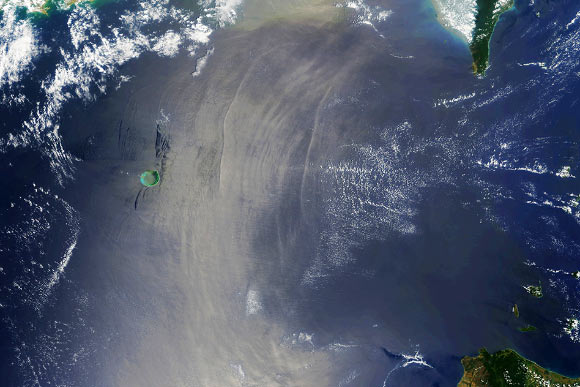In a large-scale lab and field study, a multinational team of researchers has revealed the origins of huge underwater waves.

This satellite image shows internal waves in the Luzon Strait, the South China Sea. Image credit: NASA / Global Ocean Associates.
These internal waves are hidden entirely within the ocean and can tower hundreds of feet, with profound effects on the climate and on ocean ecosystems.
They resemble surface waves in shape. The only difference between an underwater wave and the water around it is its density, due to temperature or salinity differences that cause ocean water to become stratified.
Though invisible to the eye, the boundary between colder, saltier water below and warmer, less-salty water above can be detected instrumentally. That boundary layer can resemble the ocean’s surface, producing waves that reach towering heights, travel vast distances, and can play a key role in the mixing of ocean waters, helping drive warm surface waters downward and drawing heat from the atmosphere.
Because these waves are hard to detect, it is often a challenge to study them directly in the ocean.
Dr Thomas Peacock from the Massachusetts Institute of Technology and his co-authors conducted large-scale laboratory experiments to study the production of internal waves in the Luzon Strait, between Taiwan and the Philippines.
“These are the most powerful internal waves discovered thus far in the ocean,” said Dr Peacock, who is the senior author of a paper published in the Geophysical Research Letters.
These waves have been observed to reach heights of 170 m (550 feet) and can travel at a leisurely pace of a few cm per second.
The experiments on the generation of such waves used a detailed topographic model of the Luzon Strait’s seafloor, mounted in a 50-foot-diameter rotating tank in Grenoble, France. They showed that internal waves are generated by the entire ridge system on that area of seafloor, and not a localized hotspot within the ridge.
“It’s an important missing piece of the puzzle in climate modeling,” Dr Peacock said.
These waves are potentially the key mechanism for transferring heat from the upper ocean to the depths, so the focus of the study was to determine exactly how the largest of these waves, as revealed through satellite imagery of the Luzon Strait region, are generated.
“The existence of internal waves in oceans has been known for well over a century, but they have remained poorly understood because of the difficulty of observations,” Dr Peacock said.
“Among the new techniques that have helped to propel the field forward is the use of satellite data. While the submerged waves raise the surface of the water by less than an inch, long-term satellite data can clearly discern this difference.”
______
Mercier MJ et al. 2013. Large-scale, realistic laboratory modeling of M2 internal tide generation at the Luzon Strait. Geophysical Research Letters, vol. 40, no. 21, pp. 5704–5709; doi: 10.1002/2013GL058064







